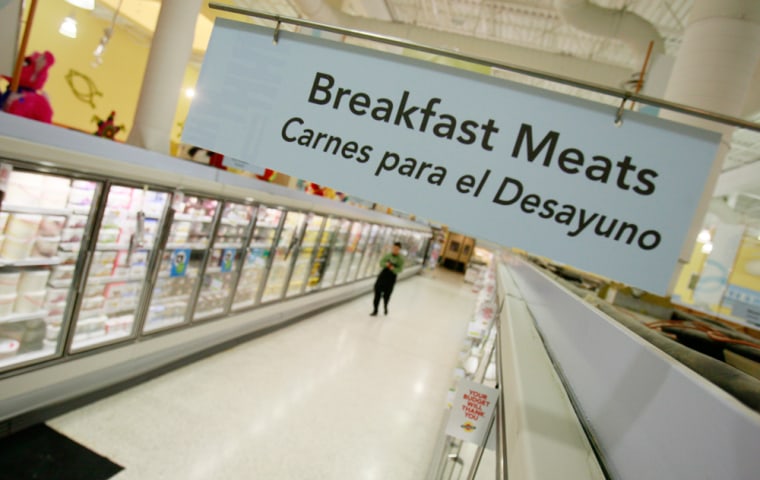After moving to the U.S. 10 years ago, Juana Carabarin still wanted to cook Mexican food for her family but often didn't have time to go to specialty shops for the ingredients.
Now the Publix grocery in Norcross, Ga., near her home carries products used in Mexican cuisine — including corn husks for tamales, chilis in the spice aisle, chorizo and queso fresco in the refrigerator case and some branded items. And she no longer has to make do with stand-ins.
Several major chains are expanding their specialty offerings to capture business from Latinos, the country's fastest-growing population and already almost one-sixth of the U.S. total in 2008. Other retailers are opening new stores that target Hispanic shoppers.
Wal-Mart Stores Inc., the nation's largest retailer, is in the process of converting two of its stores in Phoenix and Houston to Supermercados — a test format aimed at Hispanic shoppers. Its wholesale subsidiary, Sam's Club, is opening a store in Houston this summer — called Mas, or "more" — that targets Hispanic shoppers and businesses.
And Lakeland, Fla.-based Publix, which has run a line of Publix Sabor stores for years geared toward Florida's Cuban, Puerto Rican and other Latino shoppers, recently began expanding its Hispanic offerings at its Publix stores in other areas of heavy Latino population, like the store in Georgia where Carabarin shops.
Developing new stores or venturing into new markets may seem like a dicey proposition during a recession, but a recent U.S. Census report shows the Hispanic population grew 3.2 percent between 2007 and 2008. Better serving an existing and rapidly growing population could pay off well for retailers.
Hispanic consumers tend to shop for groceries more often than the average U.S. consumer, cook from scratch more often, buy more fresh items and spend an estimated 20 percent more at the store, according to the Food Marketing Institute.
At the Food Marketing Institute's last count, in 2005, Hispanic consumers spent considerably more on groceries than average U.S. consumers: an average of $133 per week per household versus $91. They also estimate Hispanics direct an estimated 34 percent of their grocery shopping outside their primary grocery store, compared with 18 percent among general U.S. shoppers.
It's that 34 percent these retailers aim to recapture.
Sam's Club said Mas will sell mainstream U.S. products as well as brands and items not often found in the states. Mas will feature a fresh tortilla shop, expanded produce, meat and bakery sections, a full-service health clinic and financial services — through a partner company that is popular in Mexico.
Mas also will have a business side, catering to restaurants, stores or other businesses that want Hispanic-oriented products in one spot with the benefit of its buying power.
While some grocers still contain their Hispanic offerings to an "ethnic" aisle, some experts say the popularity of Hispanic products among Latino and other consumers merits more attention.
"I think there is an increase in appetite across the board for more international experiences, particularly in Hispanic grocery," said Stephen Palacios, executive vice president at consulting company Cheskin Added Value. "The ethnic-specific aisle is eventually going to evolve into everybody's aisle."
A major challenge for retailers will be accurately understanding this diverse and dispersed population.
Felipe Korzenny, director of the Center for Hispanic Marketing Communication at Florida State University, said other retailers who have failed in their attempts to market to Hispanics have failed to understand the nuances among its customers. But he said if Wal-Mart and others simply change the sign out front, that won't be enough.
Wal-Mart says its Supermercados are much more. At its recently opened Houston site, the meat department offers sweet breads, milanesa (a type of veal) and arrachera (similar to skirt steak, for grilling), and the bakery sells fresh corn tortillas.
The new stores — which build on the offerings of Wal-Mart's existing stores and add bilingual signs and a different layout — are more relevant to Hispanic customers, the company says. Wal-Mart often modifies a store to target a micro-market, including installing hitching posts at an Ohio store near a large Amish population and a bike repair shop at a store in a bicycle-friendly community in Texas.
"It's not about putting the same store into every market," spokeswoman Amy Wyatt-Moore said.
Food, more than bicycles or hitching posts, may be key to pulling in new ethnic groups and especially Latinos.
Paul Bryan, director of account planning at Bromley Communications in San Antonio, Texas, the largest ad agency targeting the Hispanic market, said traditional cuisine is a crucial component of the Hispanic experience.
"Food is probably a strong cultural pillar for any culture, but it does seem to play a very strong role in the Hispanic population," he said.
